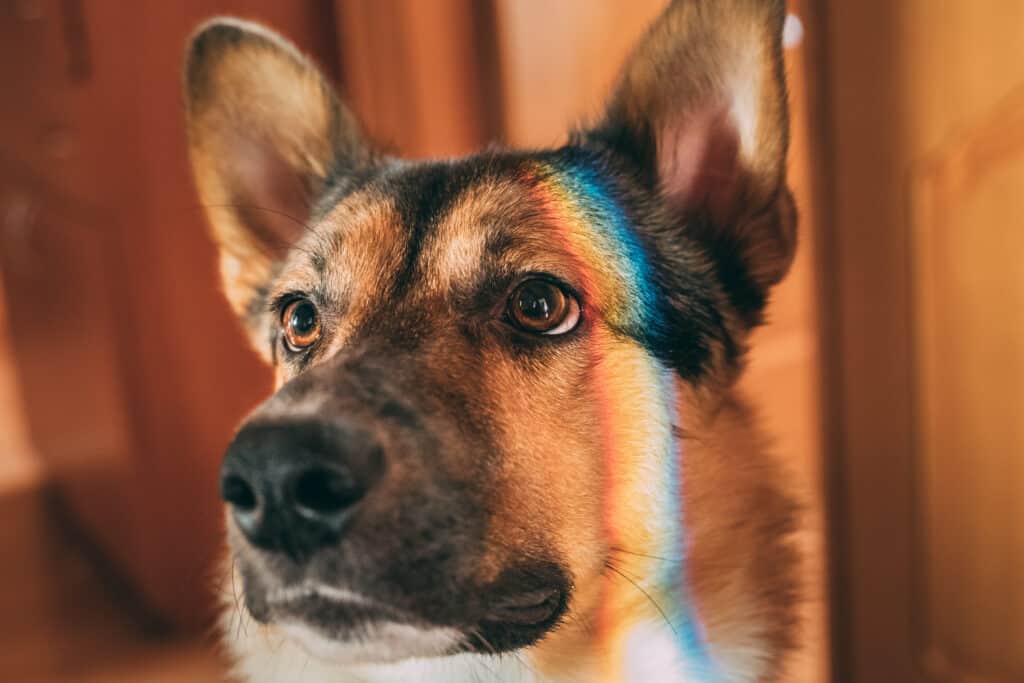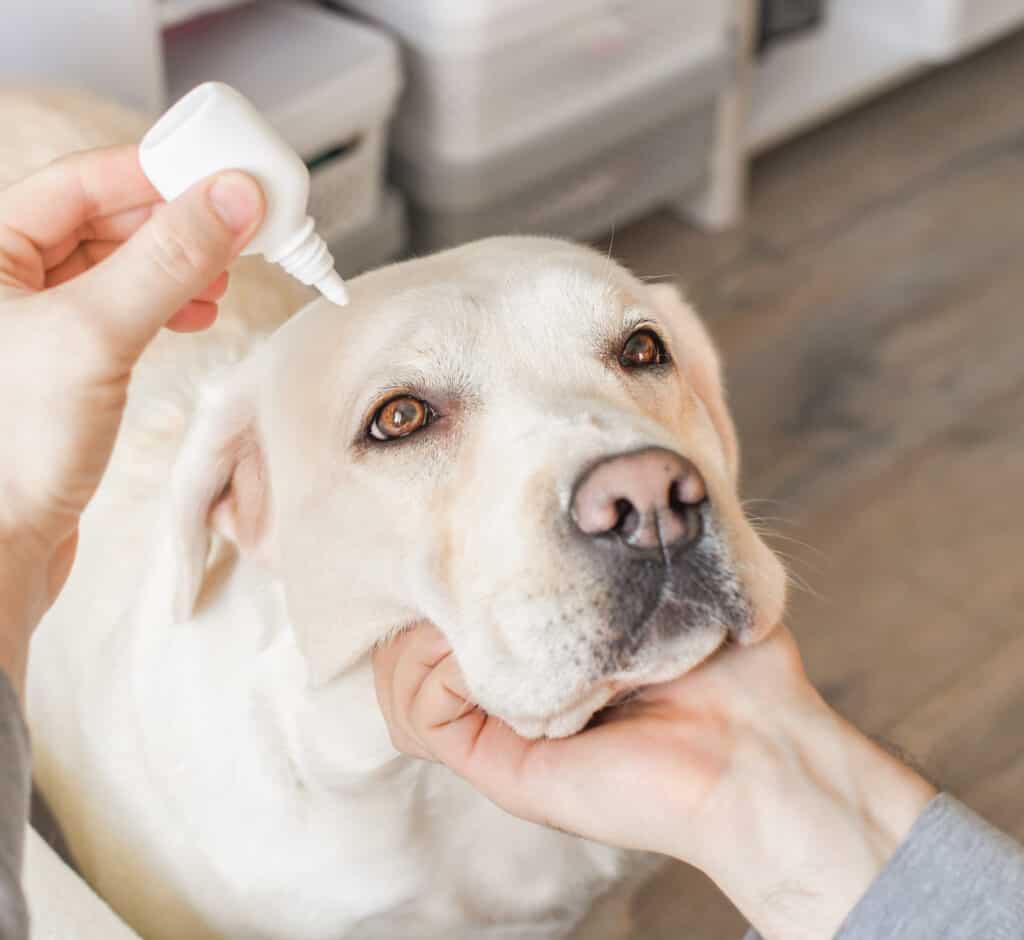Many pet parents wonder how their dogs see the world. The persistent myth about how dogs see is that dogs see in white, black, and gray.
Do dogs see in color? What is the mechanism behind their ability to see the way they do? Let us look at these questions and understand how dogs see before sticking to the old myths about canine vision.
Can Dogs See Colors?
Dogs being able to see only black and white is a concept that the world has long accepted. Even so, new findings about canine behavior and anatomy prove that dogs can see specific colors. This makes it still worthwhile for you to get brightly colored toys for your pup. Your canine companion can still appreciate some colors, after all.
Color blindness was first studied during the late 18th century. John Dalton and his brother studied this condition because they could not see certain colors. The most common form of color blindness is the defect in recognizing red and green. Abnormalities in the retinal cones are the main cause of color blindness.
People who do not have these photoreceptors cannot detect specific light wavelengths. That is why they are color blind, even if they can see some types of hues. Those with red-green color blindness can still recognize blue and yellow. Yet, they will see red as brown or gray.
Decades of canine eye research have exposed the basic differences in the basic eye design of dogs and humans. Through centuries of evolution, dogs have developed night-hunting senses. They can track and hunt their food in the cover of darkness. This makes their eyesight efficient in detecting movement in low-light environments.
The large corneal and lens surfaces, combined with a reflective membrane and more rods, make a dog’s eyes more effective in the dark. Humans have more cones than rods, making them better at seeing colors during the day. These are the differences in color perception between humans and dogs.
Humans have three cones, while dogs only have two. Dogs can see blue and yellow. That is why they prefer toys that come in these colors.

Dogs actually can see color, but not as many colors as humans
©Grisha Bruev/Shutterstock.com
Do Dogs Have Poor Vision?
The average field of vision in dogs is about 250 degrees. Humans only have 180 degrees. This is because your dog’s eyes are set farther apart. This wider visual field makes dogs efficient hunters.
Dogs have never needed to see a full spectrum of colors while hunting or for survival. That is why their cones stayed at two. Even so, dogs can pick up motion better. Dogs have a special type of vision that allows them to help their humans better.
Do Dogs Use Their Noses to See?
The sense of smell is the first thing puppies use at birth. They find their way to their mother’s milk with their nose while their eyes are still shut. As a puppy becomes a dog, the sense of smell only becomes more efficient.
A dog’s nose can catch and isolate individual scents. This means that a walk in the park can deliver specific smells. These odors register in your dog’s brain. Your dog tends to associate these odors with memories.
Smelling can assist your dog in determining the source of the odor. This can provide your dog with different types of information about the experience. Dogs can inhale and exhale through different nasal passages. The small air currents let them take in more odor molecules.
The tissue fold in the nostrils directs the odors into separate passages. The first one is for oxygenated air. The second is for smells. Passage number two has about 300 million olfactory receptor cells. Humans only have five million.
The vomeronasal organ above your dog’s mouth enables your dog to detect different hormones. This allows your dog to determine which animal is harmful or friendly. It can also help spot possible mates. Your dog can even tell if you are sick, upset, happy, or pregnant.
The sense of smell also helps your dog to track and identify odors. That is why your dog knows it is you before you even arrive. How much of your dog’s brain is solely for smelling? 40% more than that of a human.
Depending on the breed, dogs can have 125 to 250 million smell receptors. Canines can smell different things up to about 40 feet underneath the ground. They can even smell week-old fingerprints. Smelling can help your dog see better.

A dog’s sense of smell is approximately 40 times more powerful than ours.
©Cryber/Shutterstock.com
If You Want to Spot Visual Problems in Your Dog, Learn to Be More Aware
Looking into your dog’s eyes allows you to connect with your dog. Part of caring for your furry companion is knowing how to spot any visual problems. Your dog may already have symptoms of eye problems. Being more aware of your dog’s eye health can help spot, treat, and prevent eye issues.
Look Into Your Dog’s Eyes More Often
An eye inspection can happen at any time with your dog. Paying close attention to your dog’s eyes can help pinpoint any abnormality or changes. Noticing any will need a visit to the vet. Brachiocephalic breeds and older dogs have a high risk of developing eye issues. Long-haired dog breeds will need regular trims, especially around their eyes. Keeping your dog’s hair short can help keep the eyes free from injury or irritation.
Take Time to Test Your Dog’s Eyesight
Dogs are creatures of habit. You will notice a break in your dog’s routine behavior, and you will know if there is something wrong. Your dog may be having difficulty getting around the house or finding the water bowl. These may indicate vision problems in your dog.
You can set up a simple obstacle course in either a well-lit or a dim room. This will allow you to see if your dog bumps into any of the objects you set up. You can also look for a menace response. Do this by waving a closed fist at your dog’s eyes. Your dog should blink if your dog still has vision.
Dropping two to three cotton balls in front of your pup is another vision test. Your dog should give a reaction to the cotton balls. The absence of a reaction could mean that your dog’s vision is fading. Your vet can provide a formal diagnosis and discuss treatment options with you.
Products That Can Help Protect and Improve Your Dog’s Vision
Seeing the warning signs of an eye problem can give your dog an early diagnosis and treatment. Some cases involve pain and difficulty in performing daily activities. Below are some of the products that can help protect and enhance your dog’s vision:
For Cloudy Eyes
A dog’s eyes become cloudy with age. This is because of the hardening of the lens or nuclear sclerosis. This condition does not block a dog’s eyesight until your dog reaches 14 or 15 years old. Consider giving your dog the best fish oil to help the eyes remain well-lubricated by its tears. The oil in tears helps the lubrication last longer. This supplement can help prevent tears from drying up.
For Squinting
This is a common symptom of corneal abrasions. This could occur with discomfort. Bring your dog to the vet if it does not go away in one or two days. Giving your dog fish oil like salmon oil can help reduce inflammation. This will be helpful in keeping your dog’s eyes comfortable as you and your dog explore the world.
For Eye Discharge
This may indicate dry eye syndrome. A thick and yellow discharge can ooze out of your dog’s eyes as a result of eye irritation. This is often the result of low tear production. Your vet can prescribe some treatments and products that can help.
For a Third Eyelid
This becomes visible because of eye irritation and pain. A dog’s eyes tend to sink back in its socket when it is irritated or painful. This allows the third eyelid to come up and cover the eye. Normally, the third eye can also appear when the dog is relaxed enough to sleep. Medications prescribed by the vet can help with this condition.
For Unequal Sizes of Pupils
This can result from eye inflammation or a corneal growth. It could also mean that your dog has a detached retina or glaucoma. Iris atrophy can also happen when your dog reaches a certain age.
Older dogs are at risk of developing diabetes. Giving your aging dog the best dog food for diabetic dogs can help regulate your pet’s blood sugar levels. This can then prevent the onset of more eye diseases. Eye ailments may result from this chronic disease. Wearing high-quality protective goggles like Rex Specs can protect your dog’s eyes from foreign bodies that could trigger more irritation and swelling.

©shadows_photo/Shutterstock.com
Conclusion
Checking your dog’s eyes regularly for any unusual growths, discharge, or shape in your dog’s eyes can result in the early detection of ailments. This can then result in early treatments. Any dog has the capability to hide any symptom. Showing any weakness is not in their book. It is up to you to provide them with extra care and attention. Doing so can help your dog see the world better as aging sets in.
Up Next…
Ready for more reading? Try one of these articles next!
Red Eyes in Dogs – Read this to learn more about what causes red eyes in dogs and how to treat them.
What Are Tear Stains Under Dogs Eyes? – Discover why dogs get staining eye discharge and how to get rid of it.
Best Dog Goggles – Check out our top picks for dog goggles in this buying guide.
The photo featured at the top of this post is © Masarik/Shutterstock.com
Ready to discover the top 10 cutest dog breeds in the entire world?
How about the fastest dogs, the largest dogs and those that are -- quite frankly -- just the kindest dogs on the planet? Each day, AZ Animals sends out lists just like this to our thousands of email subscribers. And the best part? It's FREE. Join today by entering your email below.
Thank you for reading! Have some feedback for us? Contact the AZ Animals editorial team.







